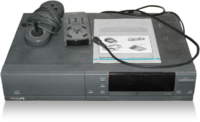| Site Notice |
|---|
|
We have a limited coverage policy. Please check our coverage page to see which articles are allowed. |
Difference between revisions of "Philips CD-i"
m (Text replacement - "Zelda Wiki" to "Zeldapedia") |
|||
| Line 43: | Line 43: | ||
*{{wp|Philips CD-i|Philips CD-i on Wikipedia}} | *{{wp|Philips CD-i|Philips CD-i on Wikipedia}} | ||
*{{smw|Philips CD-i|Philips CD-i on Super Mario Wiki}} | *{{smw|Philips CD-i|Philips CD-i on Super Mario Wiki}} | ||
| − | *{{zw|Philips CD-i|Philips CD-i on | + | *{{zw|Philips CD-i|Philips CD-i on Zeldapedia}} |
{{stub}} | {{stub}} | ||
{{Nintendo console}} | {{Nintendo console}} | ||
[[Category:Consoles]] | [[Category:Consoles]] | ||
Revision as of 22:16, 19 October 2022
| Philips CD-i | ||||||||||
| ||||||||||
| ||||||||||
| ||||||||||
| ||||||||||
| ||||||||||
|
The Philips CD-i is a home multimedia device released in 1991 by Philips. Acting in some ways similar to a modern-day DVD player, the CD-i was supposed to represent a revolutionary new era for media players - a single device that could play not just music CDs but also video games.
The CD-i was the result of a failed deal between Nintendo and Sony to create a CD-based add-on for the SNES called the PlayStation Experimental. Sony, however, wanted a large share of the profit from this add-on, as well as the right to brand it with their logo. Without warning, Nintendo canceled the deal, moving to Sony's rival Philips to make the same add-on. Sony's research and development on the PlayStation Experimental led to the release of the PlayStation console in 1996 as a rival to the Nintendo 64.
When Nintendo eventually backed out of the deal with Philips, Philips demanded to use several of Nintendo's characters in games for the CD-i, leading to the notoriously poor Zelda: The Wand of Gamelon, Link: The Faces of Evil, Zelda's Adventure, and Hotel Mario.
Models
The Philips CD-i was released in a number of models by Phillips depending on the market:
- CD-i player 200 series: includes the CD-i 205, 210, and 220 models, marketed toward the general public.
- CD-i player 300 series: includes the CD-i 310, 350, 360, and 370 models, marketed for professional use.
- CD-i player 400 series: includes the CD-i 450, 470, and 490 models, slimmed-down units marketed toward the console and educational markets.
- CD-i player 900 series: includes the CD-i 601, 602, 604, 605, 615, 660, and 670 models, marketed toward professional software developers, not made available for the general market.
External links
| This article is a stub. You can help NintendoWiki by expanding it. |
| |||||||||||||||||||||
| |||||||||||||||||||||
| |||||||||||||||||||||


